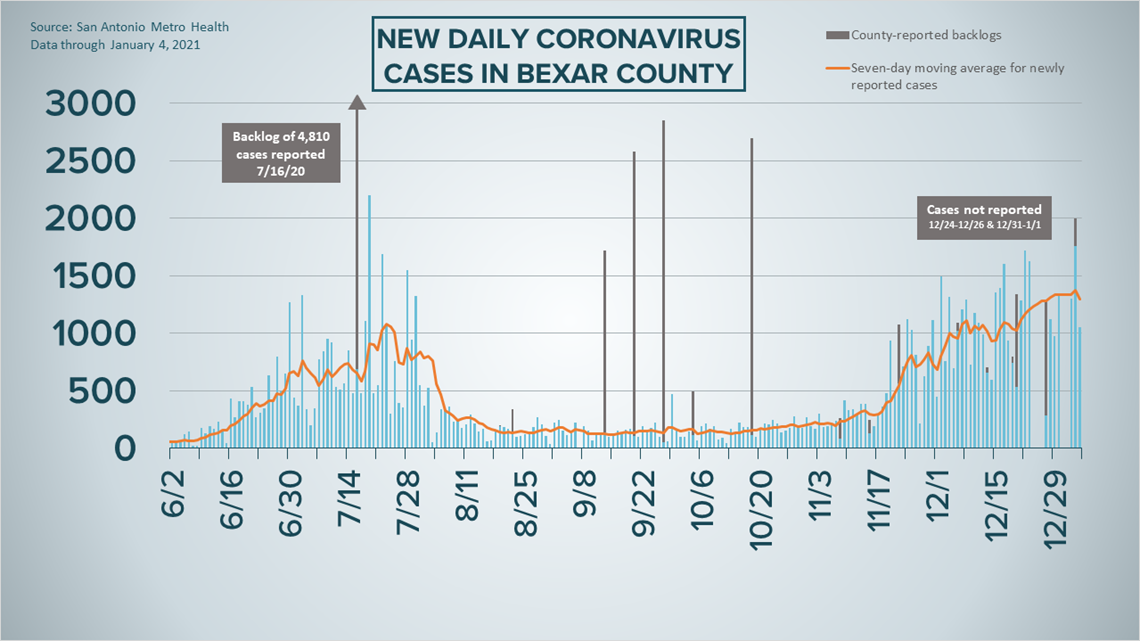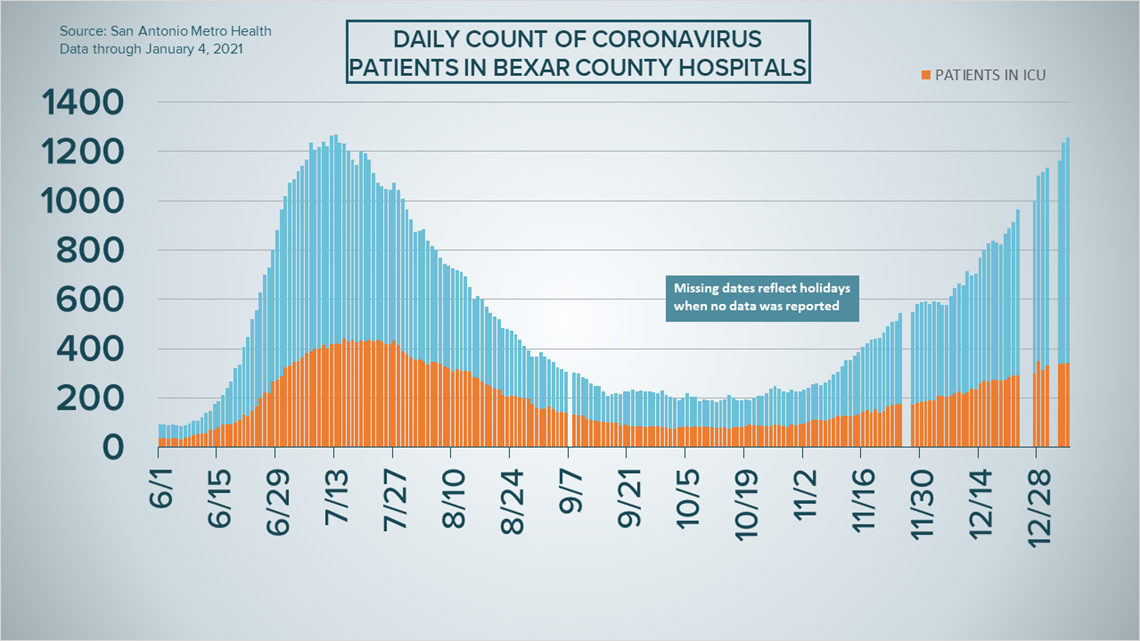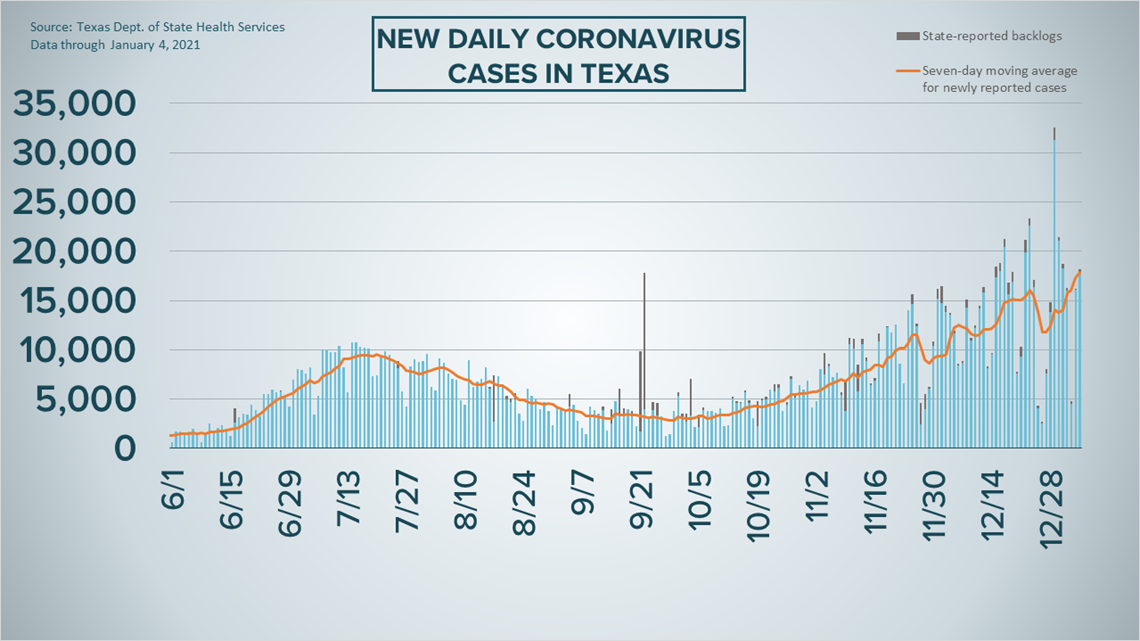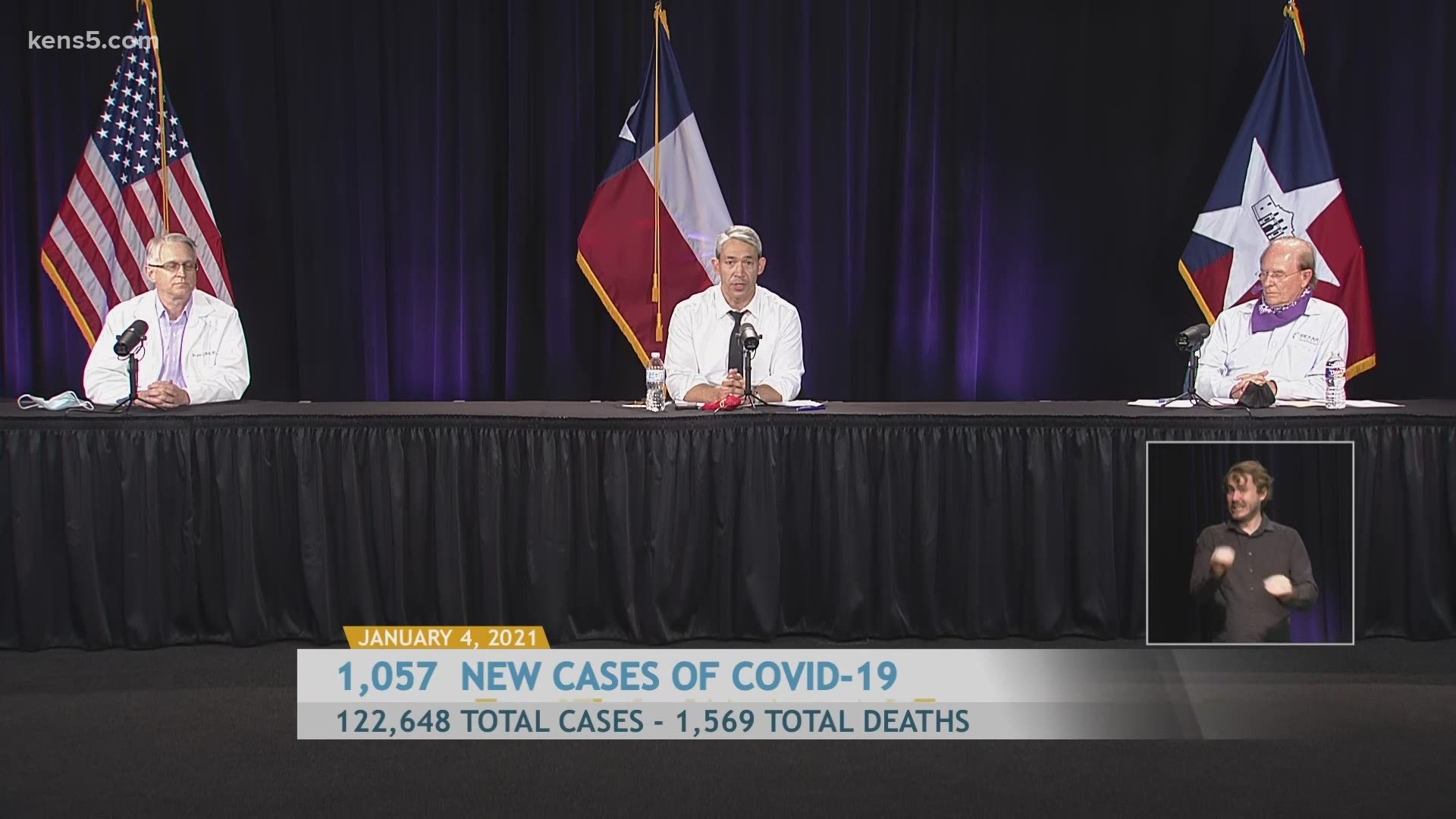SAN ANTONIO — We're tracking the latest numbers from the coronavirus pandemic in San Antonio and across Texas. Here are the latest numbers reported by Bexar and surrounding counties:
- Bexar County: On Monday, 1,057 new cases were reported, bringing the total number of cases to 122,648. Seven new deaths were also reported, bringing the local death toll from coronavirus complications to 1,569.
- Hays County: Officials in Hays County on Monday reported 323 new cases in the county and seven additional COVID-related fatalities. As of Monday, there are a total of 10,958 lab-confirmed local cases (1,737 of which are active), while the death toll increased to 133. 9,088 residents have recovered from the virus.
- Comal County: Comal County officials on Tuesday reported 170 new cases and five additional COVID-related fatalities. There are a total of 6,545 cases, including 3,925 confirmed and 2,611 probable cases, while 168 county residents have died due to COVID-19 complications. The county estimates 5,504 residents have recovered, while 873 are still ill with the virus.
More county case information is available through the Texas Department of Health Services COVID-19 dashboard.
Stay updated with our latest information coronavirus vaccines and local vaccine distribution with our ongoing Vaccine Tracker.
How Bexar County is trending
We've tracked how many coronavirus cases have been confirmed in Bexar County from the time officials began reporting cases in March 2020. The graphic below shows the number of cases since June and charts those daily case numbers along a 7-day moving average to provide a more accurate picture of the overall coronavirus case curve in our area and the direction we're trending amid the pandemic.
On Monday evening, Mayor Ron Nirenberg reported an additional 1,057 cases of the novel coronavirus in Bexar County, raising the case total to 122,648. While that's nearly half the amount of new cases reported on Sunday, city officials also reported that the positivity rate has increased by four percentage points to 23.2%.


Meanwhile, the number of COVID-19 hospitalizations in the county is nearing a pandemic high-water mark of 1,267 from back in July. On Monday, there were a total of 1,259 residents receiving treatment in local hospitals (two are from the El Paso area).
Of those 1,259, 342 patients are in intensive care and 186 are on ventilators.


Coronavirus in Texas
The total number of novel coronavirus cases in the state since the pandemic began grew by 18,182 on Monday, according to the Texas Department of State Health Services. That total includes 15,976 new confirmed cases, 1,963 new probable cases and 243 cases attributed to backlogs not previously reported in the state's total (more details can be found at the top of this page).
As of Monday, more than 1.811 million Texans have been diagnosed with COVID-19.


State health authorities also reported 52 additional virus-related deaths on Monday. At least 27,969 Texans have died from COVID-19 complications.
Meanwhile, the number of Texans receiving treatment at hospitals for coronavirus symptoms on Monday to 12,961, setting a record high for a third straight day. Hospitalizations have risen by 43% since Dec. 1, a continuation of a fall/winter coronavirus surge that began in early October and continues to trend in the wrong direction.
The state estimates that about 1.465 million Texans have recovered, while 306,522 Texans remain ill with COVID-19.
The latest update from the Texas Education Agency showed that there have been at least 98,601 cumulative cases among staff and students across the state through Dec. 20. That number comprises 62,675 positive student cases and 35,926 staff cases. More information can be found here.
The TEA releases new data on school cases on Fridays.
Latest Coronavirus Headlines
- COVID-19 Vaccine Tracker: Fast facts and how to participate in Phase 1B distribution in San Antonio
- Frequently asked questions about the second stimulus check
- UK prime minister orders new virus lockdown for England
- Austin doctor tests positive after getting COVID-19 vaccine, calls it 'bad luck'
- Johnson & Johnson's single-dose vaccine next to seek emergency use authorization
- Fauci: 'Glimmer of hope' as vaccinations increase, but post-holiday coronavirus surge likely
- Surge feared as US coronavirus death toll hits 350,000
- Houstonians hopeful after being the first to receive Moderna's COVID-19 vaccine
- ‘No, we can’t take your family member': California funeral homes overrun during COVID-19 surge
Coronavirus symptoms
The symptoms of coronavirus can be similar to the flu or a bad cold. Symptoms include fever or chills, cough, shortness of breath or difficulty breathing, fatigue, muscle or body aches, headache, new loss of taste or smell sore throat, congestion or runny nose, nausea or vomiting, and diarrhea, according to the Centers for Disease Control.
Most healthy people will have mild symptoms. A study of more than 72,000 patients by the Centers for Disease Control in China showed 80 percent of the cases there were mild.
But infections can cause pneumonia, severe acute respiratory syndrome, kidney failure, and even death, according to the World Health Organization. Older people with underlying health conditions are most at risk.
But infections can cause pneumonia, severe acute respiratory syndrome, kidney failure, and even death, according to the World Health Organization. Older people with underlying health conditions are most at risk.
Experts determined there was consistent evidence these conditions increase a person's risk, regardless of age:
- Chronic kidney disease
- COPD (chronic obstructive pulmonary disease)
- Obesity (BMI of 30 or higher)
- Immunocompromised state (weakened immune system) from solid organ transplant
- Serious heart conditions, such as heart failure, coronary artery disease, or cardiomyopathies
- Sickle cell disease
- Type 2 diabetes
The CDC believes symptoms may appear anywhere from two to 14 days after being exposed.
Human coronaviruses are usually spread...
- Between people who are in close contact with one another (within about 6 feet).
- Through respiratory droplets produced when an infected person coughs, sneezes or talks. These droplets can land in the mouths or noses of people who are nearby or possibly be inhaled into the lungs.
- Some recent studies have suggested that COVID-19 may be spread by people who are not showing symptoms.
Help stop the spread of coronavirus
- Stay home when you are sick.
- Eat and sleep separately from your family members
- Use different utensils and dishes
- Cover your cough or sneeze with your arm, not your hand.
- If you use a tissue, throw it in the trash.
Find a Testing Location
City officials recommend getting a COVID-19 test if you experience fever or chills, cough, shortness of breath or difficulty breathing, fatigue, muscle or body aches, headache, new loss of taste or smell, sore throat, congestion or runny nose, nausea or vomiting, or diarrhea.
San Antonio operates several no-cost testing locations, including two walk-up locations open Monday-Sunday from 10 a.m. until 2 p.m.:
Cuellar Community Center
5626 San Fernando St.
San Antonio, TX 78237
Ramirez Community Center
1011 Gillette Blvd.
San Antonio, TX 78224
Additionally, Freeman Coliseum offers drive-through no-cost testing from Monday through Sunday between 9 a.m. and 4 p.m. An appointment is required and can be made either online or by calling (833) 213-0643.
Here's a Testing Sites Locator to help you find the testing location closest to you in San Antonio. And here are the dates and times that city-run testing sites will be operating over the holidays.

